Functional and Taxonomic Overlap in Shore Fish Assemblages in a Tropical Seascape
Abstract
:1. Introduction
2. Materials and Methods
2.1. Sampling
2.2. Life History Traits and Biological Parameters
2.3. Functional Entities
2.4. Relative Richness and Species Accumulation Curves
3. Results
3.1. Taxonomy
3.1.1. Species
3.1.2. Genera
3.1.3. Families
3.2. Diet and Trophic Level
3.3. Other Traits
3.4. Functional Entities
4. Discussion
4.1. Extent of the Survey
4.2. Overlap
4.3. Exclusiveness
4.3.1. Reefs
4.3.2. Mangroves
4.3.3. Soft-Bottoms
5. Conclusions
Supplementary Materials
Author Contributions
Funding
Institutional Review Board Statement
Data Availability Statement
Acknowledgments
Conflicts of Interest
References
- Faunce, C.; Serafy, J. Mangroves as fish habitat: 50 years of field studies. Mar. Ecol. Prog. Ser. 2006, 318, 1–18. [Google Scholar] [CrossRef] [Green Version]
- Adams, A.J.; Dahlgren, C.P.; Kellison, G.T.; Kendall, M.S.; Layman, C.A.; Ley, J.A.; Nagelkerken, I.; Serafy, J.E. Nursery function of tropical back-reef systems. Mar. Ecol. Prog. Ser. 2006, 318, 287–301. [Google Scholar] [CrossRef]
- Blaber, S.J.M. Mangroves and fishes: Issues of diversity, dependence, and dogma. Bull. Mar. Sci. 2007, 80, 457–472. [Google Scholar]
- Nagelkerken, I. Are non-estuarine mangroves connected to coral reefs through fish migration? Bull. Mar. Sci. 2007, 80, 595–607. [Google Scholar]
- Nagelkerken, I.; Blaber, S.J.M.; Bouillon, S.; Green, P.; Haywood, M.; Kirton, L.G.; Meynecke, J.-O.; Pawlik, J.; Penrose, H.M.; Sasekumar, A.; et al. The habitat function of mangroves for terrestrial and marine fauna: A review. Aquat. Bot. 2008, 89, 155–185. [Google Scholar] [CrossRef] [Green Version]
- Barnes, L.; Bellwood, D.R.; Sheaves, M.; Tanner, J.K. The use of clear-water non-estuarine mangroves by reef fishes on the Great Barrier Reef. Mar. Biol. 2012, 159, 211–220. [Google Scholar] [CrossRef]
- Du, J.; Xie, M.; Wang, Y.; Chen, Z.; Liu, W.; Liao, J.; Chen, B. Connectivity of fish assemblages along the mangrove-seagrass-coral reef continuum in Wenchang, China. Acta Oceanol. Sin. 2020, 39, 43–52. [Google Scholar] [CrossRef]
- Sambrook, K. Beyond the Reef: The Influence of Seascape Structure on the Composition and Function of Tropical Fish Communities. Ph.D. Thesis, James Cook University, Townsville, Australia, 2021; 230p. [Google Scholar]
- Hemingson, C.R.; Bellwood, D.R. Greater multihabitat use in Caribbean fishes when compared to their Great Barrier Reef counterparts. Estuar. Coast. Shelf Sci. 2020, 239, 106748. [Google Scholar] [CrossRef]
- Igulu, M.M.; Nagelkerken, I.; Dorenbosch, M.; Grol, M.G.G.; Harborne, A.; Kimirei, I.; Mumby, P.; Olds, A.; Mgaya, Y. Mangrove Habitat Use by Juvenile Reef Fish: Meta-Analysis Reveals that Tidal Regime Matters More than Biogeographic Region. PLoS ONE 2014, 9, e114715. [Google Scholar] [CrossRef] [Green Version]
- Kulbicki, M.; Parravicini, V.; Bellwood, D.R.; Arias-González, J.E.; Chabanet, P.; Floeter, S.; Friedlander, A.; McPherson, J.; Myers, R.E.; Vigliola, L.; et al. Global Biogeography of Reef Fishes: A Hierarchical Quantitative Delineation of Regions. PLoS ONE 2013, 8, e81847. [Google Scholar] [CrossRef]
- Fricke, R.; Kulbicki, M.; Wantiez, L. Checklist of the fishes of New Caledonia. Stuttg. Beitr. Naturkd. A 2011, 4, 341–463. [Google Scholar]
- Kulbicki, M. Biogeography of reef fishes of the French territories in the South Pacific. Cybium 2007, 31, 275–288. [Google Scholar]
- Payri, C.; de Forges, R. Compendium of Marine Species from New Caledonia; The Research Institute for Development: Marseille, France, 2006. [Google Scholar]
- Thollot, P. Les Poissons de Mangrove du Lagon Sud-Ouest de Nouvelle-Calédonie. Ecologie des Peuplements. Relations avec les Communautés Ichtyologiques Côtières. Ph.D. Thesis, University Aix-Marseille II, Marseille, France, 1992; 406p. [Google Scholar]
- Thollot, P. Importance of mangroves for Pacific reef fish species, myth or reality? In Proceedings of the Seventh International Coral Reef Symposium, Guam, Micronesia, 22–27 June 1992; University of Guam Press: Mangilao, GU, USA, 1992; Volume 2, pp. 934–941. [Google Scholar]
- Wantiez, L. Les Poissons des Fonds Meubles du Lagon Nord et de la Baie de St Vincent de Nouvelle Calédonie. Description des Peuplements. Structure et Fonctionnement des Communautés. Ph.D. Thesis, Université Aix-Marseille, Marseille, France, 1992; 444p. [Google Scholar]
- Kulbicki, M. Ecologie des Poissons Lagonaires de Nouvelle Calédonie. Ph.D. Thesis, Université de Perpignan, Perpignan, France, 2006; 194p. [Google Scholar]
- Laroche, J.; Baran, E.; Rasoanandrasana, N.B. Temporal patterns in a fish assemblage of a semiarid mangrove zone in Mada-gascar. J. Fish Biol. 1997, 51, 3–20. [Google Scholar] [CrossRef] [PubMed]
- Acosta, A. Use of Multi-mesh Gillnets and Trammel Nets to Estimate Fish Species Composition in Coral Reef and Mangroves in the Southwest Coast of Puerto Rico. Caribb. J. Sci. 1997, 33, 45–57. [Google Scholar]
- Lugendo, B.R.; Nagelkerken, I.; Kruitwagen, G.; van der Velde, G.; Mgaya, Y.D. Relative importance of mangroves as feeding habitats for fishes: A comparison between mangrove habitats with different settings. Bull. Mar. Sci. 2007, 80, 497–512. [Google Scholar]
- Bellwood, D.R.; Streit, R.P.; Brandl, S.J.; Tebbett, S.B. The meaning of the term ‘function’ in ecology: A coral reef perspective. Funct. Ecol. 2019, 33, 948–961. [Google Scholar] [CrossRef] [Green Version]
- Guillemot, N.; Kulbicki, M.; Chabanet, P.; Vigliola, L. Functional Redundancy Patterns Reveal Non-Random Assembly Rules in a Species-Rich Marine Assemblage. PLoS ONE 2011, 6, e26735. [Google Scholar] [CrossRef] [Green Version]
- Mouillot, D.; Villéger, S.; Parravicini, V.; Kulbicki, M.; Arias-González, J.E.; Bender, M.; Chabanet, P.; Floeter, S.R.; Fried-lander, A.; Vigliola, L.; et al. Functional over-redundancy and high functional vulnerability in global fish faunas on tropical reefs. Proc. Natl. Acad. Sci. USA 2014, 111, 13757–13762. [Google Scholar] [CrossRef] [Green Version]
- Tillman, D. The ecological consequences of changes in biodiversity: A search for general principles. Ecology 1999, 80, 1455–1474. [Google Scholar] [CrossRef]
- McCann, K.S. The stability-diversity debate. Nature 2000, 405, 228–233. [Google Scholar] [CrossRef]
- Parravicini, V.; Villéger, S.; McClanahan, T.R.; Arias-González, J.E.; Bellwood, D.R.; Belmaker, J.; Chabanet, P.; Floeter, S.R.; Friedlander, A.M.; Guilhaumon, F.; et al. The vulnerability framework indicates alternative global protection priorities for coral reef fishes. Ecol. Lett. 2014, 17, 1101–1110. [Google Scholar] [CrossRef] [PubMed]
- Andréfouët, S.; Torres-Pulliza, D. Atlas des Récifs Coralliens de Nouvelle-Calédonie; IFRECOR: Noumea, Nouvelle-Calédonie, 2004; 26p. [Google Scholar]
- Dugas, F.; Debenay, J.P. Carte Sédimentologique et Carte Annexe du Lagon de Nouvelle Calédonie au 1/50000: Feuille La Tontouta; ORSTOM: Paris, France, 1980; 52p. [Google Scholar]
- Virly, S. Atlas des Mangroves de Nouvelle Calédonie; ZONECO: Noumea, New Caledonia, 2008; 208p. [Google Scholar]
- Kulbicki, M.; Bozec, Y.M.; Labrosse, P.; Letourneur, Y.; Mou-Tham, G.; Wantiez, L. Diet composition of carnivorous fishes from coral reef lagoons of New Caledonia. Aquat. Living Resour. 2005, 18, 231–250. [Google Scholar] [CrossRef] [Green Version]
- Rivaton, J.; Bourret, P. Otoliths of the Indo-Pacific Fishes; IRD Technical Reports, Special Issue; Research Institute for Development: Noumea, New Caledonia, 1999; 379p. [Google Scholar]
- Labrosse, P.; Kulbicki, M.; Ferraris, J. Underwater Visual Fish Census Surveys. Proper Use and Implementation; Reef Resource As-sessment Tools: Noumea, New Caledonia, 2002; 54p. [Google Scholar]
- Robertson, D.; Smith-Vaniz, W. Rotenone: An essential but demonized tool for assessing marine fish diversity. Bioscience 2008, 58, 165–170. [Google Scholar] [CrossRef] [Green Version]
- Mora, C.; Tittensor, D.; Myers, A. The completeness of taxonomic inventories for describing the global diversity and distri-bution of marine fishes. Proc. R. Soc. B Biol. Sci. 2008, 275, 149–155. [Google Scholar] [CrossRef] [PubMed] [Green Version]
- Mallet, D.; Pelletier, D. Underwater video techniques for observing coastal marine biodiversity: A review of sixty years of publications (1952–2012). Fish. Res. 2014, 154, 44–62. [Google Scholar] [CrossRef]
- Marques, T.A.; Thomas, L.; Martin, S.W.; Mellinger, D.K.; Ward, J.A.; Moretti, D.J.; Harris, D.; Tyack, P.L. Estimating animal population density using passive acoustics. Biol. Rev. 2013, 88, 287–309. [Google Scholar] [CrossRef] [PubMed] [Green Version]
- Stat, M.; John, J.; DiBattista, J.D.; Newman, S.; Bunce, M.; Harvey, E.S. Combined use of eDNA metabarcoding and video surveillance for the assessment of fish biodiversity. Conserv. Biol. 2019, 33, 196–205. [Google Scholar] [CrossRef] [Green Version]
- Boussarie, G.; Bakker, J.; Wangensteen, O.S.; Mariani, S.; Bonnin, L.; Juhel, J.-B.; Kiszka, J.J.; Kulbicki, M.; Manel, S.; Robbins, W.D.; et al. Environmental DNA illuminates the dark diversity of sharks. Sci. Adv. 2018, 4, eaap9661. [Google Scholar] [CrossRef] [Green Version]
- Nédélec, C.; Prado, J. Definition and Classification of Fishing Gear Categories; FAO Fisheries Technical Paper 222, Revision 1; Food and Agriculture Organization: Rome, Italy, 1990; 92p. [Google Scholar]
- Kulbicki, M.; MouTham, G.; Vigliola, L.; Wantiez, L.; Manaldo, E.; Labrosse, P.; Letourneur, Y. Major Coral Reef Fish Species of the South Pacific with Basic Information on Their Biology and Ecology; CRISP-IRD: Noumea, New Caledonia, 2011; 107p. [Google Scholar]
- Quimbayo, J.P.; Mendes, T.C.; Barneche, D.R.; Dias, M.S.; Grutter, A.S.; Furtado, M.; Leprieur, F.; Pellissier, L.; Mazzei, R.; Narvaez, P.; et al. Patterns of taxonomic and functional diversity in the global cleaner reef fish fauna. J. Biogeogr. 2021, 48, 2469–2485. [Google Scholar] [CrossRef]
- Luiz, O.J.; Allena, A.P.; Robertson, D.R.; Floeter, S.R.; Kulbicki, M.; Vigliola, L.; Becheler, R.; Madin, J.S. Adult and larval traits as determinants of geographic range size among tropical reef fishes. Proc. Natl. Acad. Sci. USA 2013, 110, 16498–16502. [Google Scholar] [CrossRef] [Green Version]
- Kulbicki, M. Increase in pelagic larval duration and geographical range in reef fish along an oceanic gradient. Vie Milieu 2015, 65, 1–9. [Google Scholar]
- Thomson, G.G.; Whithers, P.C.; Pianka, E.R.; Thompson, S.A. Assessing biodiversity with species accumulation curves; inven-tories of small reptiles by pit-trapping in Western Australia. Austral Ecol. 2003, 28, 361–383. [Google Scholar] [CrossRef]
- Soberon, M.J.; Llorente, B.J. The Use of Species Accumulation Functions for the Prediction of Species Richness. Conserv. Biol. 1993, 7, 480–488. [Google Scholar] [CrossRef] [Green Version]
- Blaber, S.; Brewer, D.; Salini, J. Species composition and biomasses of fishes in different habitats of a tropical Northern Australian estuary: Their occurrence in the adjoining sea and estuarine dependence. Estuar. Coast. Shelf Sci. 1989, 29, 509–531. [Google Scholar] [CrossRef]
- Krishnamurthy, K.; Jeyaseelan, M.J. Early Life History of Fishes from Pichavaram Mangrove Ecosystem of India; Rapports et Procés Verbaux des Réunions; Conseil Permanent International pour l’Exploitation de la Mer: Copenhagen, Denmark, 1981; Volume 178, pp. 416–423. [Google Scholar]
- Larsen, H. Report to Parks Australia North, on the Estuarine Fish Inventory of Kakdy National Park, Northern Territory; Research Report No. 5; Museums and Art Galleries of the Northern Territory: Darwin, Australia, 1999; 52p. [Google Scholar]
- Pittman, S.; McAlpine, C.; Pittman, K. Linking fish and prawns to their environment: A hierarchical landscape approach. Mar. Ecol. Prog. Ser. 2004, 283, 233–254. [Google Scholar] [CrossRef]
- Mallet, D.; Olivry, M.; Ighiouer, S.; Kulbicki, M.; Wantiez, L. Nondestructive Monitoring of Soft Bottom Fish and Habitats Using a Standardized, Remote and Unbaited 360° Video Sampling Method. Fishes 2021, 6, 50. [Google Scholar] [CrossRef]
- Harvey, E.S.; McLean, D.L.; Goetze, J.S.; Saunders, B.J.; Langlois, T.J.; Monk, J.; Barrett, N.; Wilson, S.; Holmes, T.; Ierodiaconu, D. The BRUVs workshop—An Australia-wide synthesis of baited remote underwater video data to answer broad-scale ecological questions about fish, sharks and rays. Mar. Policy 2021, 127, 104430. [Google Scholar] [CrossRef]
- Blaber, S.J.M.; Brewer, D.T.; Salini, J.P.; Kerr, J. Biomasses, catch rates and abundances of demersal fishes, particularly predators of prawns, in a tropical bay in the Gulf of Carpentaria, Australia. Mar. Biol. 1990, 107, 397–408. [Google Scholar] [CrossRef]
- Allen, G. Les Poissons Coralliens. Evaluation Rapide du Contexte Biologique, Ecologique et Humain de la Zone Marine du Dia-Hot-Balabio (Province Nord de Nouvelle Calédonie); The World Wide Fund for Nature: Paris, France, 2006; pp. 47–59. [Google Scholar]
- Kulbicki, M.; Williams, J.T. Preliminary checklist of the reef fishes from the Ouvea Atoll, New Caledonia. Atoll Res. Bull. 1997, 444, 26. [Google Scholar] [CrossRef]
- Hemingson, C.R.; Bellwood, D.R. Biogeographic patterns in major marine realms: Function not taxonomy unites fish assem-blages in reef, seagrass and mangrove systems. Ecography 2018, 41, 174–182. [Google Scholar] [CrossRef] [Green Version]
- Berkström, C.; Gullström, M.; Lindborg, R.; Mwandya, A.W.; Yahya, S.A.S.; Kautsky, N.; Nyström, M. Exploring ‘knowns’ and ‘unknowns’ in tropical seascape connectivity with insights from East African coral reefs. Estuar. Coast. Shelf Sci. 2012, 107, 1–21. [Google Scholar] [CrossRef]
- Sambrook, K.; Bonin, M.C.; Bradley, M.; Cumming, G.; Duce, S.; Andréfouët, S.; Hoey, A.S. Broadening our horizons: Sea-scape use by coral reef-associated fishes in Kavieng, Papua New Guinea, is common and diverse. Coral Reefs 2020, 39, 1187–1197. [Google Scholar] [CrossRef]
- Honda, K.; Nakamura, Y.; Nakaoka, M.; Uy, W.H.; Fortes, M.D. Habitat Use by Fishes in Coral Reefs, Seagrass Beds and Mangrove Habitats in the Philippines. PLoS ONE 2013, 8, e65735. [Google Scholar] [CrossRef] [PubMed] [Green Version]
- Brandl, S.J.; Goatley, C.H.R.; Bellwood, D.R.; Tornabene, L. The hidden half: Ecology and evolution of cryptobenthic fishes on coral reefs. Biol. Rev. 2018, 93, 1846–1873. [Google Scholar] [CrossRef] [PubMed]
- Brandl, S.J.; Tornabene, L.; Goatley, C.H.R.; Casey, J.M.; Morais, R.A.; Côté, I.M.; Baldwin, C.C.; Parravicini, V.; Schiettekatte, N.M.D.; Bellwood, D.R. Demographic dynamics of the smallest marine vertebrates fuel coral reef ecosystem functioning. Science 2019, 364, 1189–1192. [Google Scholar] [CrossRef] [PubMed]
- Depczynski, M.; Fulton, C.J.; Marnane, M.J.; Bellwood, D.R. Life history patterns shape energy allocation among fishes on coral reefs. Oecologia 2007, 153, 111–120. [Google Scholar] [CrossRef]
- Unsworth, R.K.; De Leon, P.S.; Garrard, S.L.; Smith, D.J.; Bell, J.J. Habitat Usage of the Thumbprint Emporer Lethrinus harak (Forsskal, 1775) in an Indo-Pacific Coastal Seascape. Open Mar. Biol. J. 2008, 3, 16–20. [Google Scholar] [CrossRef] [Green Version]
- Fulton, C.J.; Abesamis, R.A.; Berkström, C.; Depczynski, M.; Graham, N.A.J.; Holmes, T.H.; Kulbicki, M.; Noble, M.M.; Radford, B.T.; Tano, S.; et al. Form and function of tropical macroalgal reefs in the Anthropocene. Funct. Ecol. 2019, 33, 989–999. [Google Scholar] [CrossRef]
- Munday, P.L. Habitat loss, resource specialization, and extinction on coral reefs. Glob. Chang. Biol. 2004, 10, 1642–1647. [Google Scholar] [CrossRef]
- Herler, J.; Munday, P.L.; Hernaman, V. Gobies on coral reefs. In The Biology of Gobies; Science Publishers: Jersey City, NJ, USA, 2011; pp. 493–529. [Google Scholar]
- Komyakova, V.; Munday, P.L.; Jones, G.P. Relative importance of coral cover, habitat complexity and diversity in determining the structure of reef fish comunities. PLoS ONE 2013, 8, e83178. [Google Scholar]
- Wantiez, L. Trophic networks of the soft bottom fish community in the lagoon of New Caledonia. C. R. Acad. Sci. Ser. 3 Sci. Vie 1994, 317, 847–856. [Google Scholar]
- Clavier, J.; Chardy, P.; Chevillon, C. Sedimentation of particulate matter in the south-west lagoon of New Caledonia: Spatial and temporal patterns. Estuar. Coast. Shelf Sci. 1995, 40, 281–294. [Google Scholar] [CrossRef]
- Conand, F. Biologie et Ecologie des Poissons Pélagiques du Lagon de Nouvelle-Calédonie Utilisables Comme Appât Thonier. Ph.D. Thesis, Université de Bretagne Occidentale, Brest, France, 1988; 239p. [Google Scholar]
- Champalbert, G. Plankton inhabiting the surface layer of the southern and southwestern lagoon of New Caledonia. Mar. Biol. 1993, 115, 223–228. [Google Scholar] [CrossRef]

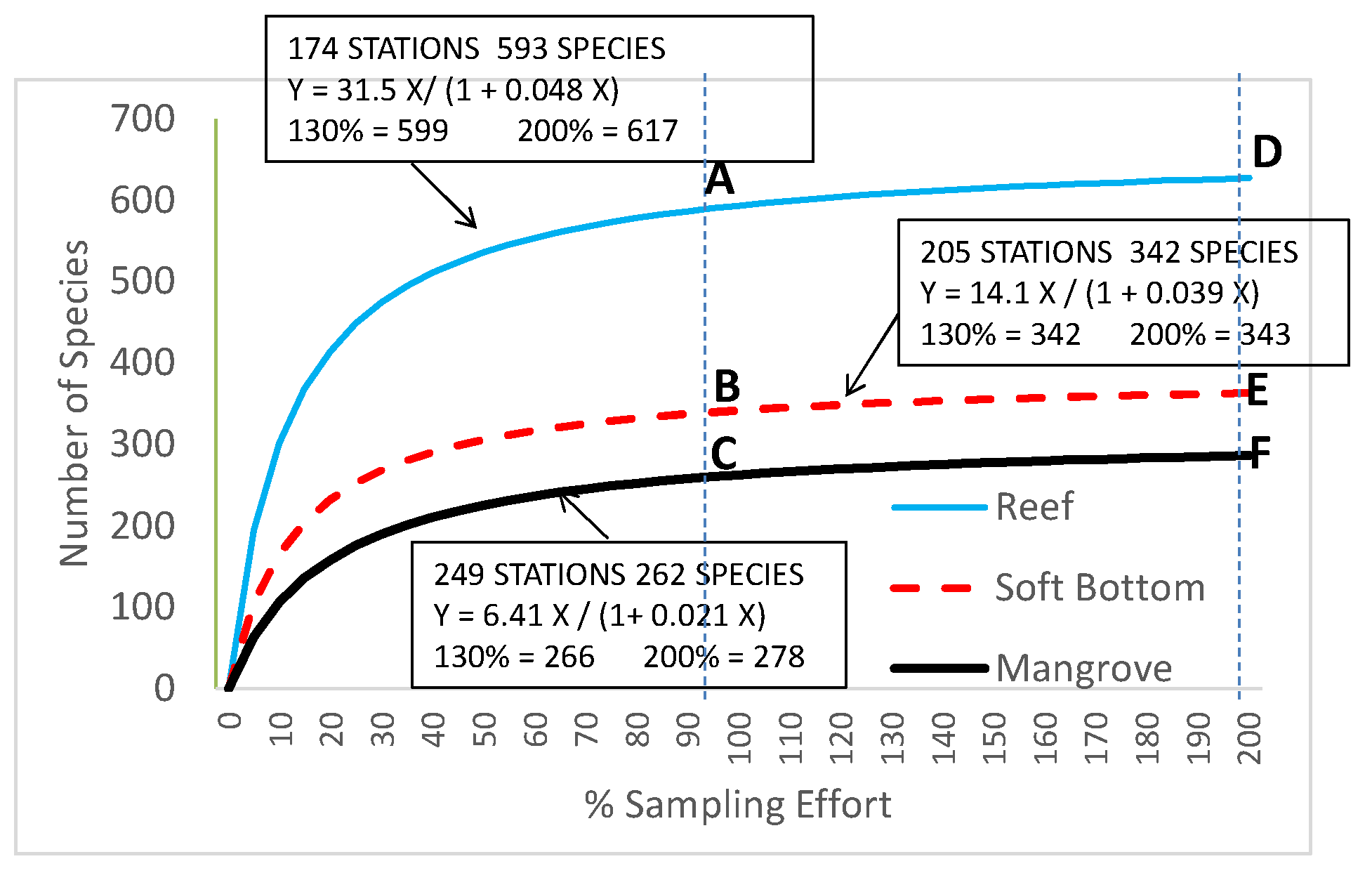
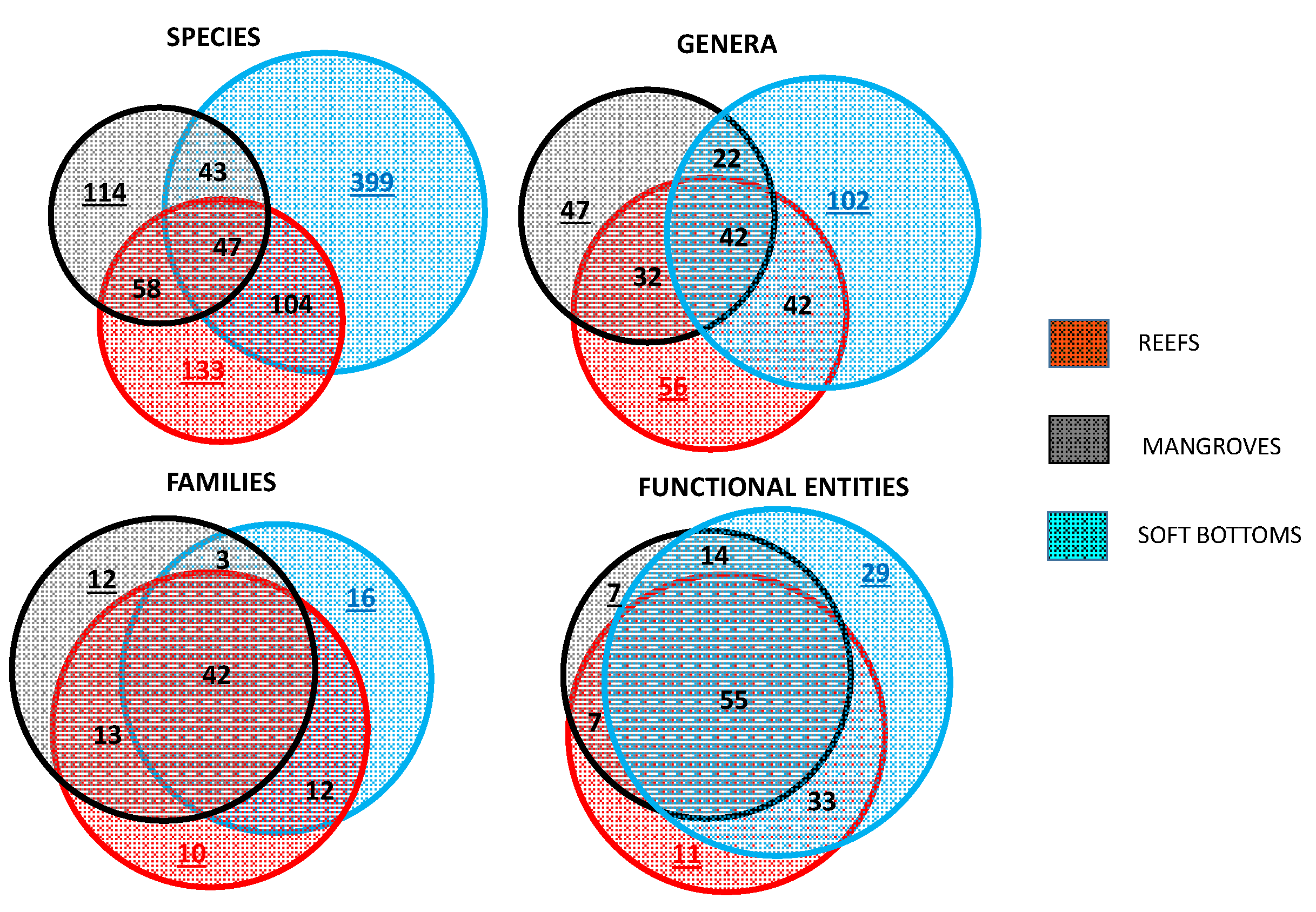
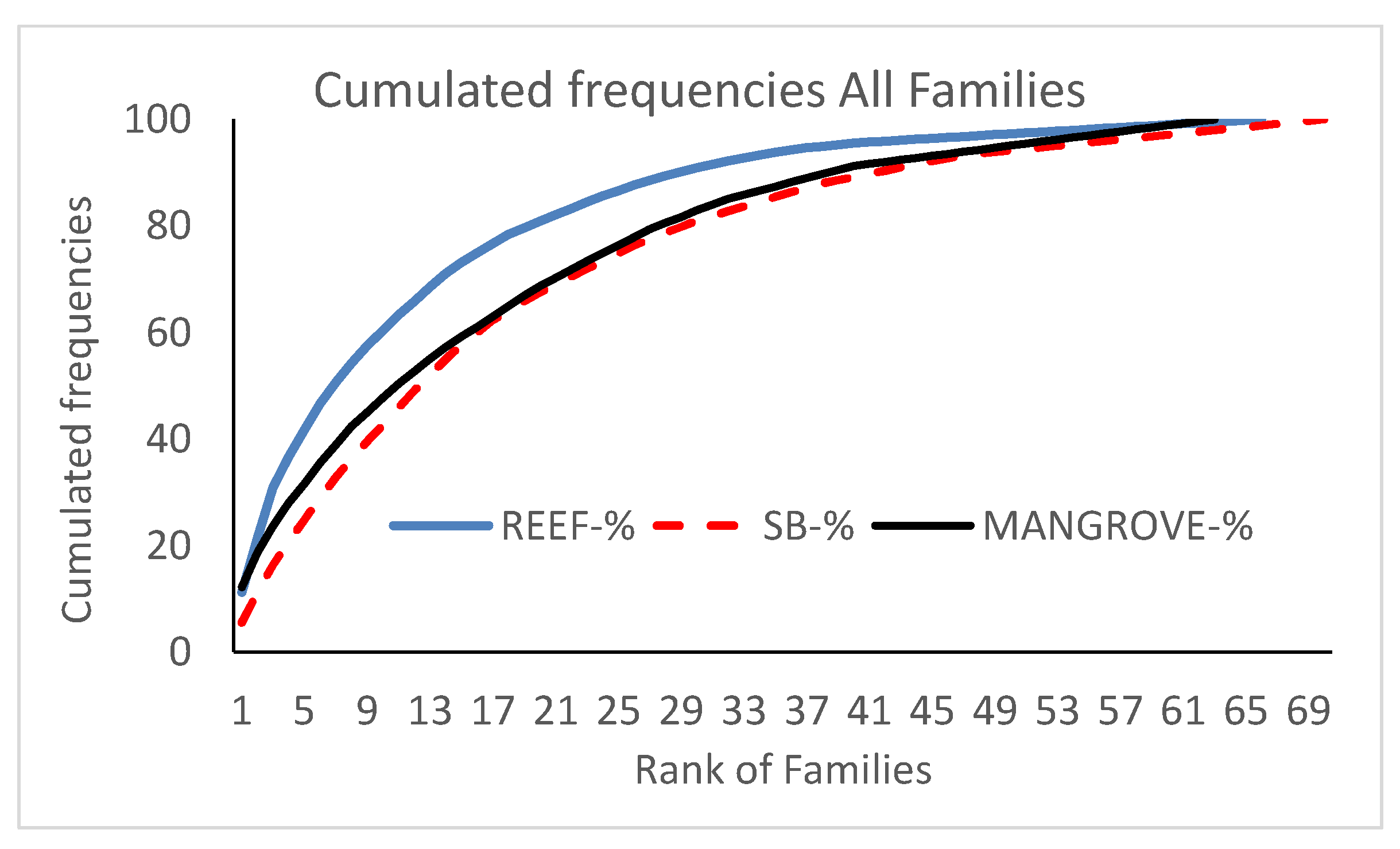
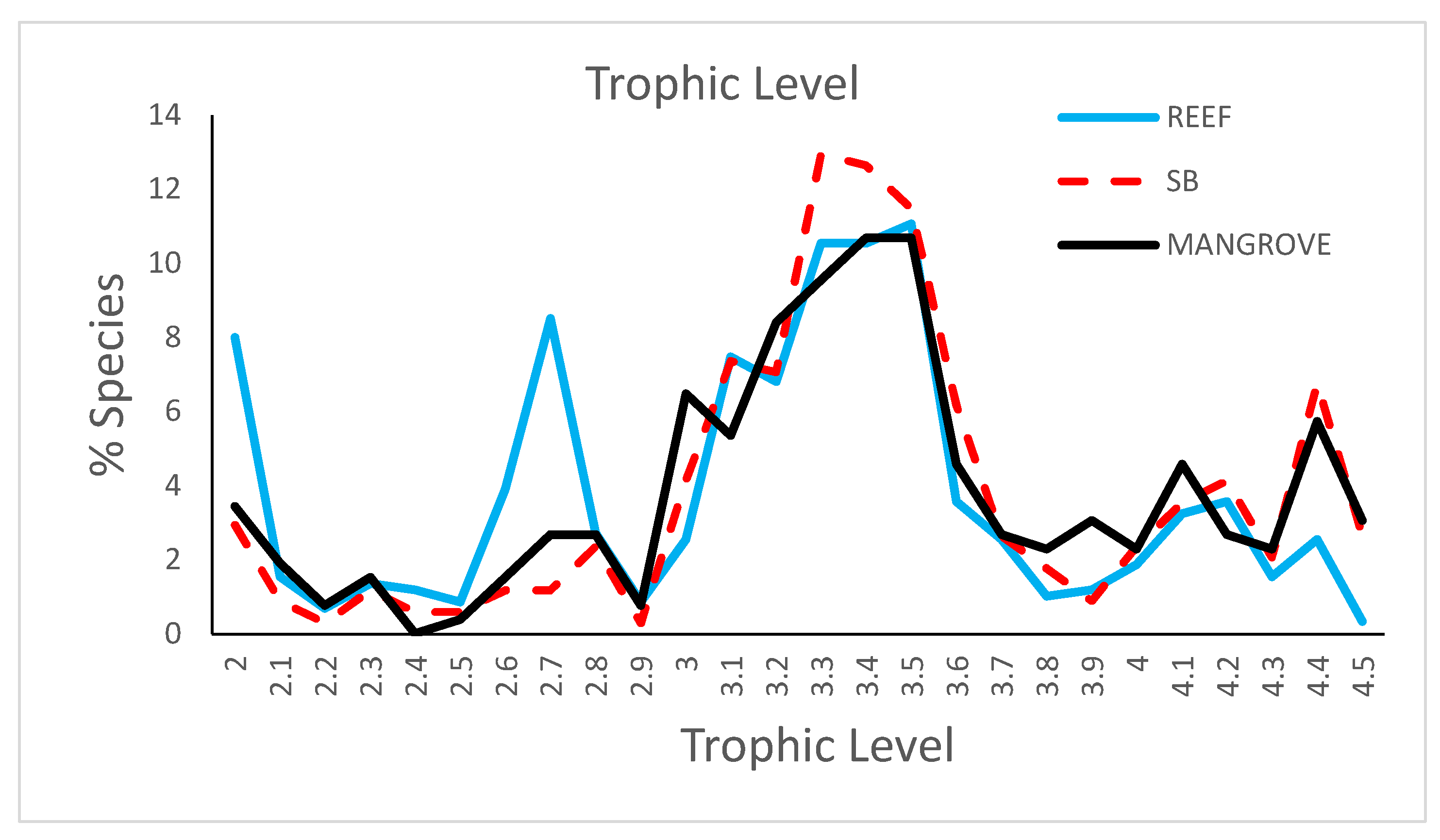
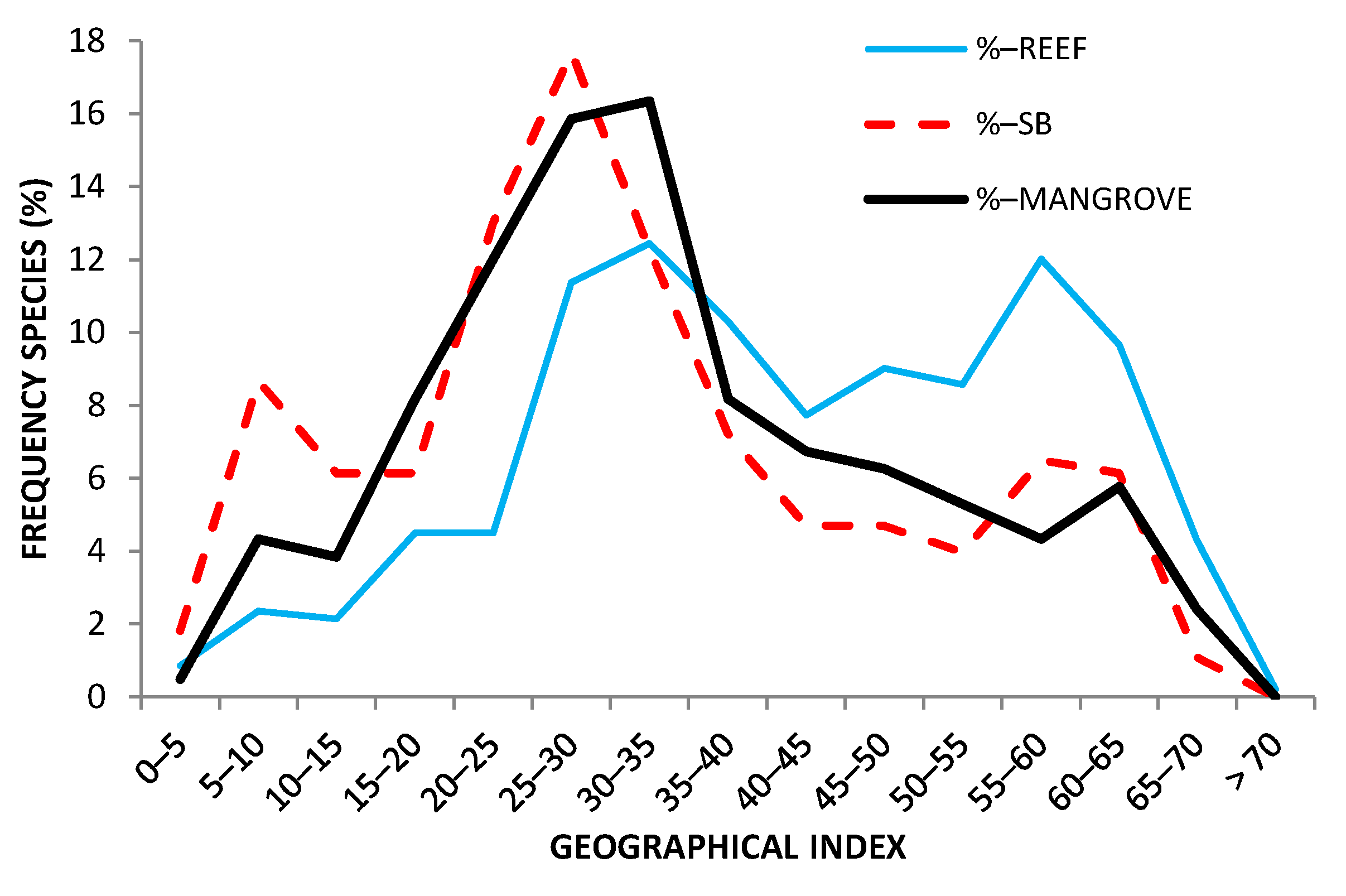
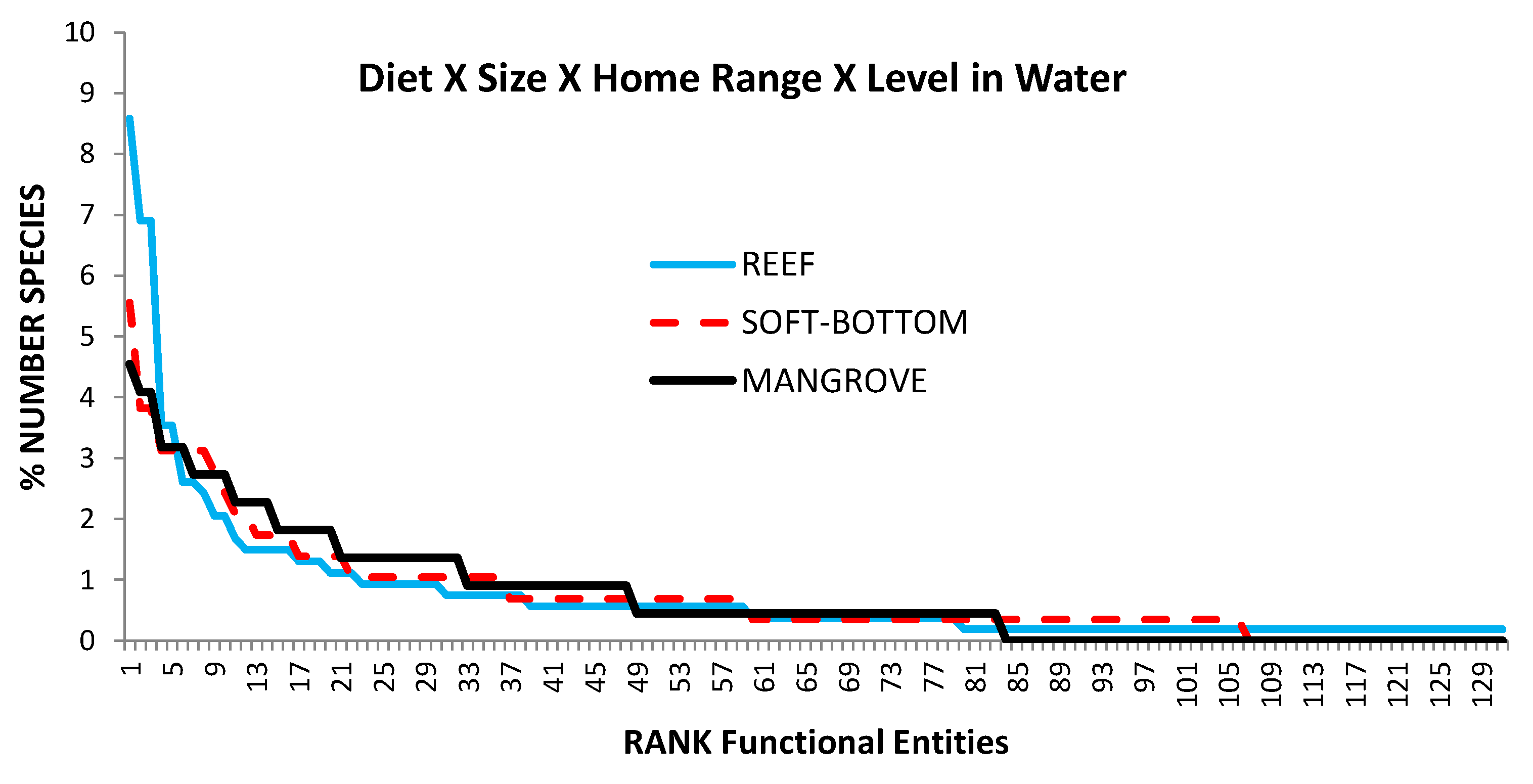
| Functional Entities | C121 | C221 | C321 | C111 | C231 | C431 | Z223 | Z224 | C421 | Z245 | P331 | P643 | C333 | C343 | P321 | P631 | C641 | Z345 | C433 | C443 | P641 |
|---|---|---|---|---|---|---|---|---|---|---|---|---|---|---|---|---|---|---|---|---|---|
| REEF | 1 | 2 | 3 | 4 | 20 | 6 | 5 | 7 | 8 | 80 | 11 | 81 | 9 | 60 | 10 | 39 | 82 | 31 | 24 | 42 | 83 |
| SOFT-BOTTOM | 37 | 2 | 3 | 156 | 1 | 4 | 17 | 18 | 22 | 5 | 6 | 7 | 12 | 8 | 24 | 38 | 9 | 10 | 14 | 16 | 27 |
| MANGROVE | 4 | 1 | 15 | 7 | 16 | 33 | 34 | 35 | 84 | 2 | 36 | 5 | 12 | 6 | 49 | 3 | 22 | 52 | 8 | 9 | 10 |
| R × SB × M | R × SB | R × M | SB × M | |
|---|---|---|---|---|
| 1 Species * | 26 | 35 | 20 | 23 |
| 2 Species * | 4 | 7 | 6 | 8 |
| 3 Species * | 3 | 5 | 3 | 2 |
| 4 Species * | 2 | 1 | ||
| 5 Species * | 2 | 1 | ||
| [1] Nb overlapping Species (in habitat combination) | 43 | 82 | 41 | 54 |
| [2] Nb Species (in habitat combination) | 781 | 742 | 556 | 352 |
| [3] Nb overlapping FE | 33 | 51 | 29 | 35 |
| [4] Nb FE | 156 | 149 | 146 | 128 |
| Redundancy (species/FE) ([2]/[4]) | 5.0 | 5.0 | 3.8 | 2.8 |
| Redundancy of overlapping species ([1]/[3]) | 1.3 | 1.6 | 1.4 | 1.5 |
| % of overlapping FE (100 × [3]/[[4]) | 21 (High) | 11 (Low) | 7 (Low) | 15 (High) |
| % of overlapping Species (100 × [1]/[2]) | 6 (Low) | 11 (High) | 7 (Low) | 15 (High) |
Publisher’s Note: MDPI stays neutral with regard to jurisdictional claims in published maps and institutional affiliations. |
© 2022 by the authors. Licensee MDPI, Basel, Switzerland. This article is an open access article distributed under the terms and conditions of the Creative Commons Attribution (CC BY) license (https://creativecommons.org/licenses/by/4.0/).
Share and Cite
Kulbicki, M.; Wantiez, L.; Thollot, P.; Tham, G.M. Functional and Taxonomic Overlap in Shore Fish Assemblages in a Tropical Seascape. Diversity 2022, 14, 310. https://doi.org/10.3390/d14050310
Kulbicki M, Wantiez L, Thollot P, Tham GM. Functional and Taxonomic Overlap in Shore Fish Assemblages in a Tropical Seascape. Diversity. 2022; 14(5):310. https://doi.org/10.3390/d14050310
Chicago/Turabian StyleKulbicki, Michel, Laurent Wantiez, Pierre Thollot, and Gérard Mou Tham. 2022. "Functional and Taxonomic Overlap in Shore Fish Assemblages in a Tropical Seascape" Diversity 14, no. 5: 310. https://doi.org/10.3390/d14050310






